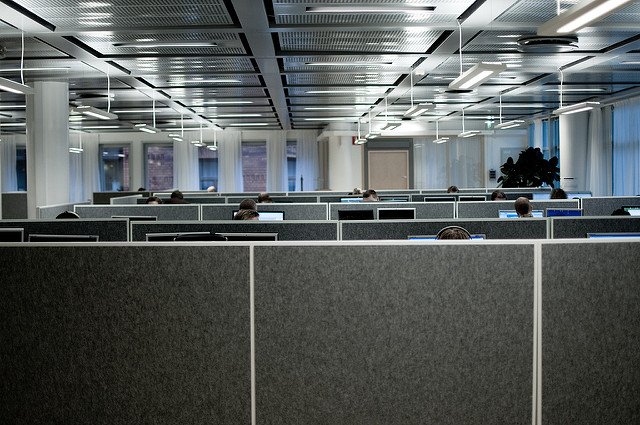In 2018, a new way to work is increasingly popular: a combo work style that blends the direct connection of being in an on-site office with workplace flexibility, or working remotely.
Employees want somewhere to collaborate and socialize with other like-minded professionals, as well as hold necessary meetings.
However, they still want the freedom to balance work and family life. Additionally, they want the environments they occupy to be aesthetically pleasing and comfortable – that way, employees feel more creative and productive.
As part of my work for Clutch, a research and review firm, I recently conducted a survey about the future of work and workspaces. The results showed that people value flexible working arrangements, but they also value community in the workplace. Here are some of the most telling points that we discovered.
How to balance in-office work with workplace flexibility
First, though, a quick history lesson on the spaces people traditionally occupied while they worked.
The history of workspaces
For decades, there was only one option for those who wanted to be part of the workforce: they had to clock into the office at 9:00 am, they would be sequestered into a small office or cubicle, and at 5:00 pm it would be time to clock out.

In the 1990’s, telecommuting, or working from a location outside the office started to become much more popular. There are two main reasons why telecommuting grew in popularity:
- The Internet was born and quickly became available to many Americans
- Amazon introduced cloud computing services in 2002 with Amazon Web Services (AWS)
There were multiple benefits of these technological advancements:
- First, a larger pool of workers became available at increasingly competitive rates.
- Second, employees could avoid spending hours in traffic, which also let them customize their schedule to fit specific work habits or cater to family life.
More and more employers now recognize that flexibility in the workplace allows workers to better balance their lives.
How to accommodate employee workspace preferences
Create a pleasing workplace
A workspace is so much more than just a chair and a desk.
In fact, 61% of those we surveyed said that an appealing, comfortable workspace was the most valuable trait in a work environment.
“I like to work in environments that are clean, bright, have some color, and are well-kept. If they are trendy, even better,” explained Sarah Mitchell, a child sleep consultant in Mountain View, California. “The state of my environment subconsciously influences my mood for the day and my productivity.”
Cater to Workplace Flexibility
Workers like different areas within the office to work independently and separate meeting spaces for collaboration, but workplace flexibility also includes the opportunity to work off-site at home, a coffee shop, or a co-working location.
A study by Dropbox and Ipsos MORI discovered that employees that have access to a flexible, collaborative workspace are 19% more likely to be happy at work than those who have neither and are 34% more likely to feel creative.
Update your office space
The ideal workspace provides workers the chance to connect, learn from each other, and have fun. Here are some ways that you can update your office to accommodate your employees:
- Incorporate sit-stand desks for employees to use. One team of researchers even determined that when compared to an afternoon of sedentary work, an equal amount of time spent standing burned over 170 additional calories. Ergonomic chairs can reduce neck and back pain.
- Make the space aesthetically pleasing. You can do this in a variety of budget-friendly ways. Try bringing in plants, opening blinds to bring in natural light, and letting employees customize their space with framed pictures or posters.
- Give employees their own space – between 120-200 feet per person – so that they feel comfortable. After all, who wants someone looking at your computer screen or bumping into your chair all day? 39% of the respondents in the Clutch survey said that a dedicated desk or office made the physical workspace most appealing followed.
How workplace flexibility benefits the company
Today, workspaces – as well as industries themselves – are evolving to meet the needs of a modern workforce.
Allowing workers the choice to work from home or from the office attracts the right talent to your company.
It also creates company loyalty and appeal. An employee who values flexibility and a pleasing environment isn’t likely to be swayed by other companies that don’t offer these perks.
Secondly, workplace flexibility means that long-term office contracts aren’t as expensive. Companies can cut down on the total amount of office space they rent.
As an alternative, they can look into local co-working spaces. Co-working spaces serve as professional workspaces full of the resources and meeting facilities that businesses need.
In-office and flexible work are best when combined
Working in an isolated office from 9 to 5 can be too inflexible for those trying to balance work and home life.
Just think of the epitome of the disconnected 9-to-5 worker: Don Draper from Mad Men.
However, doing the opposite and only telecommuting can also be too isolating. A computer screen and Slack channels are useful tools, but they can’t always stand in for real people and in-person brainstorming.
Today, work and home spaces are often blended. Home sometimes contains an office, and the office has become more home-like.
With these blurred lines between work, play, and family time, it’s important that companies continue to put their employees first.
After all, employees are the people who make work possible.
What do you think? What kind of offices do you prefer working in? I would love to hear your thoughts in the comment section below!
For more business tips, check our entrepreneurship section and subscribe to our weekly newsletters.